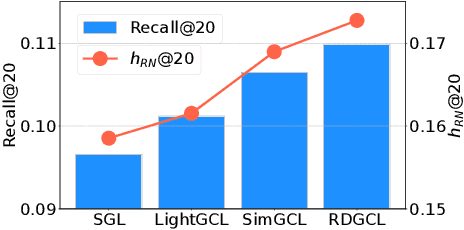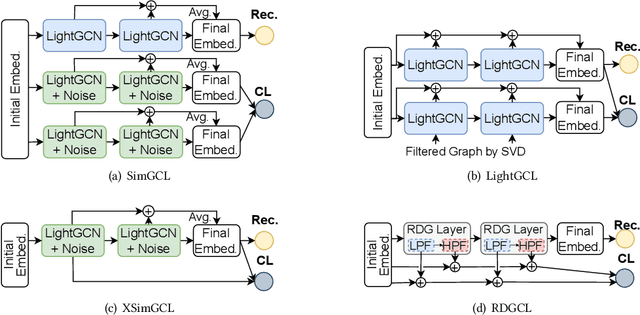Jeongwhan Choi
Possibility for Proactive Anomaly Detection
Apr 15, 2025Abstract:Time-series anomaly detection, which detects errors and failures in a workflow, is one of the most important topics in real-world applications. The purpose of time-series anomaly detection is to reduce potential damages or losses. However, existing anomaly detection models detect anomalies through the error between the model output and the ground truth (observed) value, which makes them impractical. In this work, we present a \textit{proactive} approach for time-series anomaly detection based on a time-series forecasting model specialized for anomaly detection and a data-driven anomaly detection model. Our proactive approach establishes an anomaly threshold from training data with a data-driven anomaly detection model, and anomalies are subsequently detected by identifying predicted values that exceed the anomaly threshold. In addition, we extensively evaluated the model using four anomaly detection benchmarks and analyzed both predictable and unpredictable anomalies. We attached the source code as supplementary material.
PIORF: Physics-Informed Ollivier-Ricci Flow for Long-Range Interactions in Mesh Graph Neural Networks
Apr 05, 2025Abstract:Recently, data-driven simulators based on graph neural networks have gained attention in modeling physical systems on unstructured meshes. However, they struggle with long-range dependencies in fluid flows, particularly in refined mesh regions. This challenge, known as the 'over-squashing' problem, hinders information propagation. While existing graph rewiring methods address this issue to some extent, they only consider graph topology, overlooking the underlying physical phenomena. We propose Physics-Informed Ollivier-Ricci Flow (PIORF), a novel rewiring method that combines physical correlations with graph topology. PIORF uses Ollivier-Ricci curvature (ORC) to identify bottleneck regions and connects these areas with nodes in high-velocity gradient nodes, enabling long-range interactions and mitigating over-squashing. Our approach is computationally efficient in rewiring edges and can scale to larger simulations. Experimental results on 3 fluid dynamics benchmark datasets show that PIORF consistently outperforms baseline models and existing rewiring methods, achieving up to 26.2 improvement.
Bridging Dynamic Factor Models and Neural Controlled Differential Equations for Nowcasting GDP
Sep 13, 2024Abstract:Gross domestic product (GDP) nowcasting is crucial for policy-making as GDP growth is a key indicator of economic conditions. Dynamic factor models (DFMs) have been widely adopted by government agencies for GDP nowcasting due to their ability to handle irregular or missing macroeconomic indicators and their interpretability. However, DFMs face two main challenges: i) the lack of capturing economic uncertainties such as sudden recessions or booms, and ii) the limitation of capturing irregular dynamics from mixed-frequency data. To address these challenges, we introduce NCDENow, a novel GDP nowcasting framework that integrates neural controlled differential equations (NCDEs) with DFMs. This integration effectively handles the dynamics of irregular time series. NCDENow consists of 3 main modules: i) factor extraction leveraging DFM, ii) dynamic modeling using NCDE, and iii) GDP growth prediction through regression. We evaluate NCDENow against 6 baselines on 2 real-world GDP datasets from South Korea and the United Kingdom, demonstrating its enhanced predictive capability. Our empirical results favor our method, highlighting the significant potential of integrating NCDE into nowcasting models. Our code and dataset are available at https://github.com/sklim84/NCDENow_CIKM2024.
Graph Signal Processing for Cross-Domain Recommendation
Jul 17, 2024Abstract:Cross-domain recommendation (CDR) extends conventional recommender systems by leveraging user-item interactions from dense domains to mitigate data sparsity and the cold start problem. While CDR offers substantial potential for enhancing recommendation performance, most existing CDR methods suffer from sensitivity to the ratio of overlapping users and intrinsic discrepancy between source and target domains. To overcome these limitations, in this work, we explore the application of graph signal processing (GSP) in CDR scenarios. We propose CGSP, a unified CDR framework based on GSP, which employs a cross-domain similarity graph constructed by flexibly combining target-only similarity and source-bridged similarity. By processing personalized graph signals computed for users from either the source or target domain, our framework effectively supports both inter-domain and intra-domain recommendations. Our empirical evaluation demonstrates that CGSP consistently outperforms various encoder-based CDR approaches in both intra-domain and inter-domain recommendation scenarios, especially when the ratio of overlapping users is low, highlighting its significant practical implication in real-world applications.
PANDA: Expanded Width-Aware Message Passing Beyond Rewiring
Jun 06, 2024Abstract:Recent research in the field of graph neural network (GNN) has identified a critical issue known as "over-squashing," resulting from the bottleneck phenomenon in graph structures, which impedes the propagation of long-range information. Prior works have proposed a variety of graph rewiring concepts that aim at optimizing the spatial or spectral properties of graphs to promote the signal propagation. However, such approaches inevitably deteriorate the original graph topology, which may lead to a distortion of information flow. To address this, we introduce an expanded width-aware (PANDA) message passing, a new message passing paradigm where nodes with high centrality, a potential source of over-squashing, are selectively expanded in width to encapsulate the growing influx of signals from distant nodes. Experimental results show that our method outperforms existing rewiring methods, suggesting that selectively expanding the hidden state of nodes can be a compelling alternative to graph rewiring for addressing the over-squashing.
SVD-AE: Simple Autoencoders for Collaborative Filtering
May 08, 2024Abstract:Collaborative filtering (CF) methods for recommendation systems have been extensively researched, ranging from matrix factorization and autoencoder-based to graph filtering-based methods. Recently, lightweight methods that require almost no training have been recently proposed to reduce overall computation. However, existing methods still have room to improve the trade-offs among accuracy, efficiency, and robustness. In particular, there are no well-designed closed-form studies for \emph{balanced} CF in terms of the aforementioned trade-offs. In this paper, we design SVD-AE, a simple yet effective singular vector decomposition (SVD)-based linear autoencoder, whose closed-form solution can be defined based on SVD for CF. SVD-AE does not require iterative training processes as its closed-form solution can be calculated at once. Furthermore, given the noisy nature of the rating matrix, we explore the robustness against such noisy interactions of existing CF methods and our SVD-AE. As a result, we demonstrate that our simple design choice based on truncated SVD can be used to strengthen the noise robustness of the recommendation while improving efficiency. Code is available at https://github.com/seoyoungh/svd-ae.
Stochastic Sampling for Contrastive Views and Hard Negative Samples in Graph-based Collaborative Filtering
May 01, 2024Abstract:Graph-based collaborative filtering (CF) has emerged as a promising approach in recommendation systems. Despite its achievements, graph-based CF models face challenges due to data sparsity and negative sampling. In this paper, we propose a novel Stochastic sampling for i) COntrastive views and ii) hard NEgative samples (SCONE) to overcome these issues. By considering that they are both sampling tasks, we generate dynamic augmented views and diverse hard negative samples via our unified stochastic sampling framework based on score-based generative models. In our comprehensive evaluations with 6 benchmark datasets, our proposed SCONE significantly improves recommendation accuracy and robustness, and demonstrates the superiority of our approach over existing CF models. Furthermore, we prove the efficacy of user-item specific stochastic sampling for addressing the user sparsity and item popularity issues. The integration of the stochastic sampling and graph-based CF obtains the state-of-the-art in personalized recommendation systems, making significant strides in information-rich environments.
QoS-Aware Graph Contrastive Learning for Web Service Recommendation
Jan 06, 2024Abstract:With the rapid growth of cloud services driven by advancements in web service technology, selecting a high-quality service from a wide range of options has become a complex task. This study aims to address the challenges of data sparsity and the cold-start problem in web service recommendation using Quality of Service (QoS). We propose a novel approach called QoS-aware graph contrastive learning (QAGCL) for web service recommendation. Our model harnesses the power of graph contrastive learning to handle cold-start problems and improve recommendation accuracy effectively. By constructing contextually augmented graphs with geolocation information and randomness, our model provides diverse views. Through the use of graph convolutional networks and graph contrastive learning techniques, we learn user and service embeddings from these augmented graphs. The learned embeddings are then utilized to seamlessly integrate QoS considerations into the recommendation process. Experimental results demonstrate the superiority of our QAGCL model over several existing models, highlighting its effectiveness in addressing data sparsity and the cold-start problem in QoS-aware service recommendations. Our research contributes to the potential for more accurate recommendations in real-world scenarios, even with limited user-service interaction data.
RDGCL: Reaction-Diffusion Graph Contrastive Learning for Recommendation
Dec 27, 2023



Abstract:Contrastive learning (CL) has emerged as a promising technique for improving recommender systems, addressing the challenge of data sparsity by leveraging self-supervised signals from raw data. Integration of CL with graph convolutional network (GCN)-based collaborative filterings (CFs) has been explored in recommender systems. However, current CL-based recommendation models heavily rely on low-pass filters and graph augmentations. In this paper, we propose a novel CL method for recommender systems called the reaction-diffusion graph contrastive learning model (RDGCL). We design our own GCN for CF based on both the diffusion, i.e., low-pass filter, and the reaction, i.e., high-pass filter, equations. Our proposed CL-based training occurs between reaction and diffusion-based embeddings, so there is no need for graph augmentations. Experimental evaluation on 6 benchmark datasets demonstrates that our proposed method outperforms state-of-the-art CL-based recommendation models. By enhancing recommendation accuracy and diversity, our method brings an advancement in CL for recommender systems.
Learning Flexible Body Collision Dynamics with Hierarchical Contact Mesh Transformer
Dec 19, 2023



Abstract:Recently, many mesh-based graph neural network (GNN) models have been proposed for modeling complex high-dimensional physical systems. Remarkable achievements have been made in significantly reducing the solving time compared to traditional numerical solvers. These methods are typically designed to i) reduce the computational cost in solving physical dynamics and/or ii) propose techniques to enhance the solution accuracy in fluid and rigid body dynamics. However, it remains under-explored whether they are effective in addressing the challenges of flexible body dynamics, where instantaneous collisions occur within a very short timeframe. In this paper, we present Hierarchical Contact Mesh Transformer (HCMT), which uses hierarchical mesh structures and can learn long-range dependencies (occurred by collisions) among spatially distant positions of a body -- two close positions in a higher-level mesh corresponds to two distant positions in a lower-level mesh. HCMT enables long-range interactions, and the hierarchical mesh structure quickly propagates collision effects to faraway positions. To this end, it consists of a contact mesh Transformer and a hierarchical mesh Transformer (CMT and HMT, respectively). Lastly, we propose a flexible body dynamics dataset, consisting of trajectories that reflect experimental settings frequently used in the display industry for product designs. We also compare the performance of several baselines using well-known benchmark datasets. Our results show that HCMT provides significant performance improvements over existing methods.
 Add to Chrome
Add to Chrome Add to Firefox
Add to Firefox Add to Edge
Add to Edge